Company Overview
Samsung is a South Korea based market player and electronics giant producing a range of innovative products and operating for than seventy years by carrying out successful business throughout the world with 337 offices facilitating in fifty-eight countries and employing about 222000 human resources worldwide; moreover, it is the second largest company of the world market, possessing extremely strong financial-position.
It is notable that Samsung is one of the giant players in the global market with operations in numerous countries; therefore, it possesses a complex organizational structure. However, the organizational structure of the company is illustrated in a simplified format below –

Samsung has experienced outstanding growth in spite of the adverse impact of global financial crisis and the management of this company has taken advance actions in order to reduce negative impact on the company and gain competitive advantages by using strong financial capabilities, long experience of the employees, and key strengths.
Table 1: Financial Overview of Samsung for the year 2007 to 2010. Source: Samsung Electronics (21).
Even though the after effects of the recession are still present to some extent, the sales trends of the business remained quite high as demonstrated in the chart below:

According to its sustainability report 2011, Samsung is a highly ethical business, which operates in an ecologically friendly manner and conforms to its principles of corporate social responsibility. The CSR policy framework of the business has shown below –
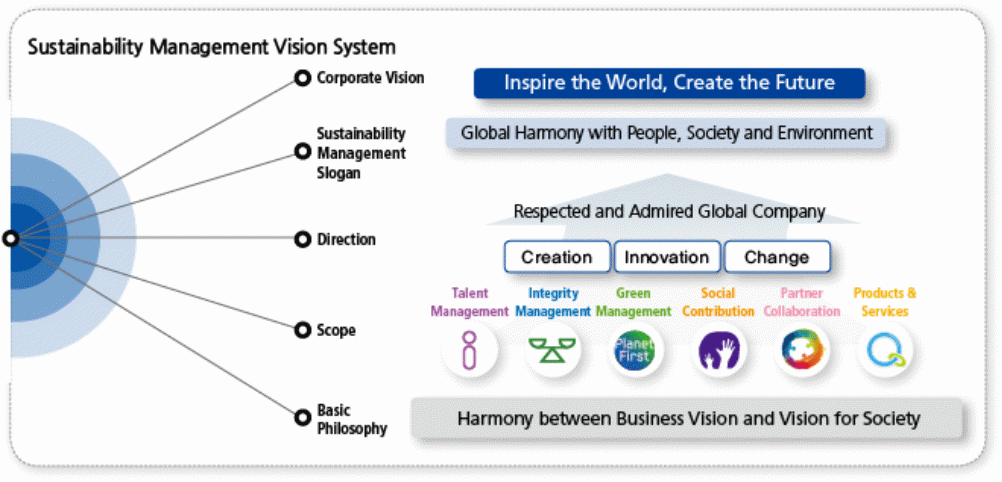
The company believes that maintaining good communication with the stakeholders by formulating an ethical stakeholder communications framework is the key to operating successfully; the stakeholder policies of the company along with the major issues in 2010 include the following:
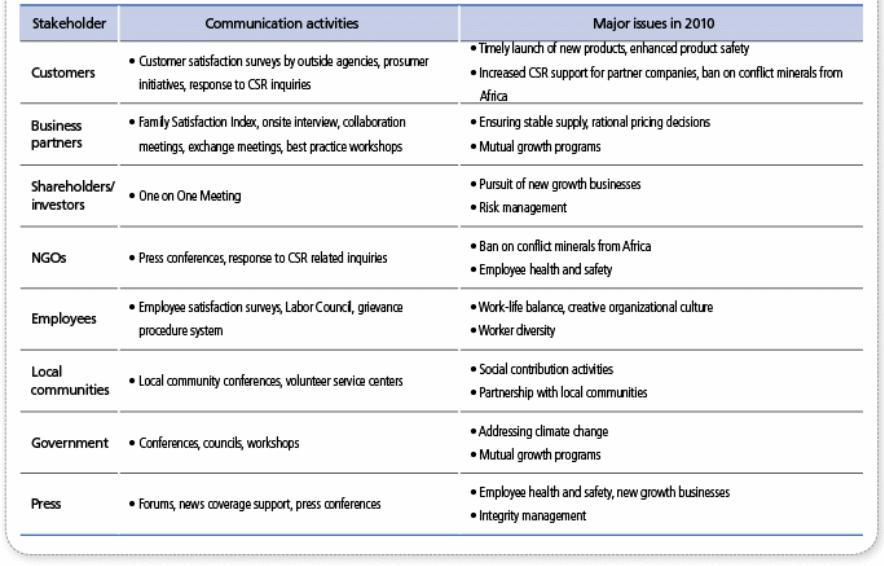
The company’s operations are carried out in terms of equal opportunities for all employees; it does not discriminate with the employees in terms of ethnic origin or race. For expatriate employees, the company follows the following diversity management framework:
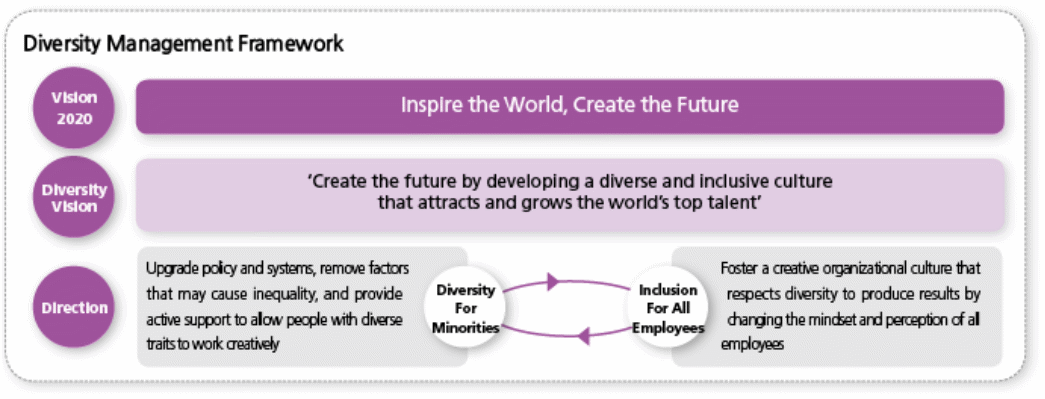
To manage the human resources efficiently, the company’s HR organizational configuration has simplified as much as possible:

Ten years history and Product lines
Samsung has a glorious history and events of its product development, here, this part of the report presented a small part of the company’s historical event for last ten years as follows-
Product line and Feature /Events
Table 2: Ten years history and product line.
Market analysis of Samsung
Market Size (current and future):
Scribd (7) reported that LG Electronics is the market leader of global consumer electronics industry and Samsung is the nearest competitor; however, the following table presents the market shares of different companies and the subsequent figure shows the position of different products of Samsung –
Table 3: Share of Consumer Electronics Industry. Source: Scribd (7).

According to the sustainability report 2010, Samsung occupies thirty three percent market shares of the digital media, eighteen percent of Semiconductor, fifteen percent LCD market share, twenty percent of telecommunication sectors and six percent market share of other sectors in global industry.
Market profitability
Market profitability will be considered in accordance with Porter’s five forces model analysis of Samsung: –
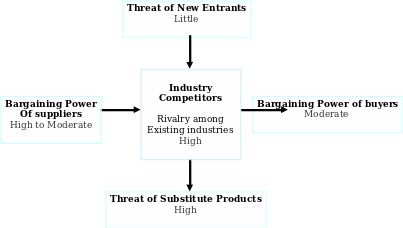
Bargaining power of suppliers
The bargaining power of suppliers is varying in accordance with the brand value of the suppliers, for instance, this power of Microsoft and Intel is more due to high demand of the products (both hardware and software) of these companies. As a result, the management of Samsung maintains good relationship with the suppliers of technology and update contract before the deadline, which reduces overall force of suppliers;
Bargaining power of buyers
According to the report of Scribd (9), the performance of the company mainly depends on the customer base. Most of the multinational companies particularly those offer consumer electronics products prefixed their target group and prepared plan to create loyal consumer base.
The bargaining power of the buyers is too high in this industry because there are many players in the market of consumer electronics those offer similar products at competitive price; however, the customer of Samsung are not willing to switch off due to advance quality and service;
Threats of substitute products
Samsung Electronics faced strong competition from both national and international rivals those firms manufactured similar consumer electronics products, which decrease the demand of any brand of this company. For example, Samsung needs to innovate new products to attract customers as the technology of this company cloned by other companies and these companies ask low price of the products;
Barriers of new entrants
Threats of new entrants in consumer electronics is minimal for the multinational company and high for small companies of developing countries because it should require large investment to enter new market. However, Samsung experienced huge success in Indian market due to low entry costs, availability of resources, low establishment costs and flexible rules and regulation; therefore, Samsung is interested to enter new markets and create loyal customer groups;
Rivalry among existing firms
Samsung has a number of competitors all over the world since consumer electronics market is highly competitive. Here, it is important to mention that the rivalry among the companies is enormous due to frequent change of customers, cloning trends of the companies, low switching off costs, lack of corporate social responsibility, future growth plan and so on.
However, Samsung’s different products have faced intense competition with different companies though most of these companies also influential buyers of Samsung, for example, following tables provide the list of major competitors and buyers of Samsung –
Table 4: Direct Competitor Comparison of consumer electronics industry.
Table 5: Major buyers of Samsung. Source: Generated from Yoo-chul (1).
Porters Value Chain Analysis of Samsung
Value chain model includes both primary and supportive functions of the company; however, value chain of Samsung Electronics includes philosophy, values and business principles to guide all employees to improve performance; however, the following figure shows it more elaborately –
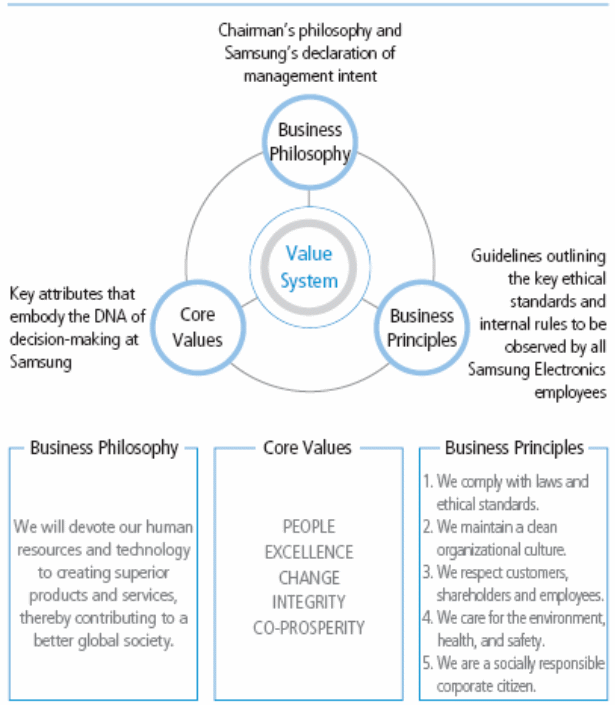
- HRM: The value system of the company has designed considering the development of the performance of the employees, as human resources are the most valuable asset. Therefore, Bokki Moon, Corporate Human Resources Team of Samsung arranges many programmes such as the global mobility programme,
- Procurement: These activities concern on supply chain management; therefore, Samsung introduced innovative logistics system like Global Logistics Network Systems (GLONETS) to connect its sales department with headquarters;
- Technology: As technology is one of the important factors for the development Samsung, it invests large amount to research to develop products.
At the same time, primary functions of Samsung are focusing on the pricing strategies, cost effective strategies, customer cares, evaluation of market position, product differentiation and new product developments, face external challenges and so on.
Distribution channels
Scribd (37) reported that Samsung is trying to boost annual sales revenue by developing distribution channels and starting operation in new market; therefore, the management of this company gives more attention on the development of the performance of subsidiaries.
According to the sustainability report 2010 of Samsung Electronics (12), this company has a total of 196 subsidiaries (manufacturing, sales, R&D subsidiaries and among them more than 80 subsidiaries are using to distribute its products and performing other functions) all over the world; however, following figure gives more information regarding this issue –
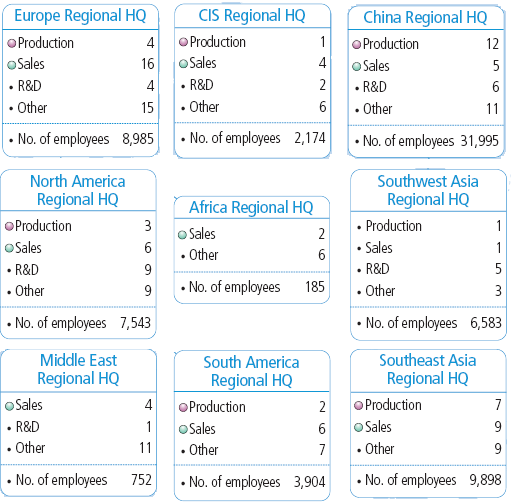
Samsung has six distributors in Europe, numerous State-level distributions and a direct dealer interface, innovative logistics system and so on.
Market trends
The marketers of Samsung products need to concentrate on the possible risks and market demands in order to understand the market trends to plan for the future expansion to gain competitive advantages.
According to the annual report 2010 of Samsung, this company observed less growth rate in developed countries (mainly EU zone) as the purchasing power of the customers of those countries is high and they like to purchase local products instead of Korean companies’ product. However, other factors influence the company to change strategy in accordance with the trends of global consumer electronics market, such as –
- Chinese customers appreciate the products of Japanese company, which helps competitors gain competitive advantages;
- Many companies of the United States (for example, Motorola) successfully developed strong distribution channel to draw attention of the customers;
- Remuneration policy for the executives create barriers for the practice of effective governance system;
- At the same time, the trends of the customers of developing and least developed countries have changed due to low price offerings of the competitors and comparatively high price of the products of Samsung.
The management of Samsung needs to take into account the above-mentioned factors and provides concentration on following factors –
- New strategy of Samsung should be more cost effective for the customers of developing countries to increase profit from global market and become market leader in this industry;
- However, global financial crisis is one of the burning challenges to this company; therefore, it needs to focus more on the vision of the company;
- It should always engage to introduce new products.
Key Success factors
- Brand awareness and strong customer base are the main success factors to this company;
- Samsung Electronics has strong presence in the global market, which is the competitive advantage over many competitors;
- Lon experience helps the company create loyal customers, which is the inspiration of the company to expand business operation all over the world;
- Financial position of the company is one of the key success factors as it is important for minimising risks of the operation system;
- This company arranges reward facilities along with six-sigma facility training to the staff, which helps Samsung to develop their performance;
- Samsung Electronics (42) published that protecting intellectual property is critical to its success; however, it includes protecting proprietary technology of the company and information of others;
- Efficient, dynamic and active employees, engineers and other members of the research and development team are the crucial success factors (Samsung Electronics 19);
- On the other hand, IT sector integration with 4G mobile communications, 32/28nm high-k metal gate (HKMG), and the 2.5-inch, 250-gigabyte (GB) HDD, 1 GB DRAM, next-generation wireless communication method Mobile WiMAX (WiBRO) and 32 GB NAND also open new dimension to gain economics of scale (Samsung Electronics 19;
- Other success factors are distinctive competencies, advance supply chain management system to control entire market, administrative control, innovative technology, and core values, CRM, activities of R&D, and so on.
Market Trends Analysis
The innovation driven global electronic giant Samsung has analysed its global market trends in January 2011, during the announcement of the 4th Quarter financial reporting while the company pointed to the weakening market trend in the global operation and at the same time as global electronics market is suffering from falling prices.
The company added that it was capable of continuing its steady growth for a few hot selling products like memory semiconductors and smart phone, while TV, LCD panels and other product line demonstrated huge competition with throat-cutting price fall and remarkably lower profitability.
Under the recessionary economy and complicated environment, the demand for ICT products has seriously fallen; consequently, the global economic marketplace has slowdown that seriously damaged the company’s profitability in the last quarter of 2010.
As a result, considering the overall market trend, the company has aimed to sustain a stable growth in 2011, depending on its traditional earnings trend while the first half of the year would be less revenue generation and less profitability and expected for better returns in the second half of the year.
Based on such a diminishing market trend, Samsung Electronics hope that the price antagonism to make stronger in the product line of end user electronics, ICT products, along with mobile handset market in 2011 as the market trend demonstrate that foremost prices of the components are declining with significance while Samsung and other competitors are striving for long-term sustainability.
To encounter with the adverse market situation and market trends, Samsung would emphasis on strategy of cost competitiveness by reducing production cost, shipment frights and marketing expenses and keep better than ever emphasis on the product, those demonstrated increasing sales in the previous year like memory and high-end smart phones.
Moreover, the market trends have driven the company to be aware with any negative impact of foreign currency mix, and strategically aimed to diversify the different currency rather than aligning with a single currency risk.
The market trends also demonstrates that Samsung has to spend a huge amount for capital expenditure due to the shifting dynamics of the market, it was predicted early that the company would spend in this regards for an amount of 10.3 trillion won, but it practically reaches 23 trillion won.
The best contributor in the revenue generation for the company is semiconductor and for the full year of 2010, the operating profit accounted 1.80 trillion won and the net profit generated for this product is 9.25 trillion won and it is the 16% better growth than the previous year.
In spite of a deteriorating market trend, Samsung leads to protect its profitability next to accelerating the segments of highly profitable products like server CPU along with mobile DRAM and 40 nm-class processes, and emphasised to enhance its market, but the products are very slow selling, by reinforcement costly product market the company has kept its efforts to get sustainability.
At the same time, DRAM memory market evidenced with seriously falling price at the first half of 2010, all other IT product line of Samsung demonstrated a mixed trend, just falling and raising, but not steady growth has not been evidenced.
Samsung always drives to add more innovative products to its product line, 1n 2007 the company added a Computer Printing to its product line and aimed to the market leader within three years, and engaged its effort to gain the market with 3-years strategy with leaser printer category.
With its charismatic strategy, the company has gained second position in the global printer market by exceeding Brother and Lexmark, while Hewlett-Packard is still at the first poison. The aggressive goal of Samsung is to accomplish the numbered one position by 2010 and to gain such is a forceful goal would necessitate choosing the right products with right solutions including a strong market strategy to address the affordability of the customers with superior service quality.
Being the pioneer of innovative technology, Samsung has positively attitude to keep its position at the top of market trends, and the company introduced the leaser printer, which is designed to convene the raising demands of the global consumers (Samsung Electronics 1).
Kim (3) pointed out that the concurrent global market has branded by means of condensed trade barriers; aggressively strengthening competitions, short-run product life cycle along with expanding market segmentation, while the companies are striving at their own ways to competitive advantages under such environment.
At the beginning of its journey Samsung is an innovation driven company who always look for competitive advantages from its innovative technology and introducing newer product line, there is evidence that the company has expended its market for 38% within a year by adding wider variety of electronics and home appliances. In the IT era, Samsung continues its innovativeness by deliberating huge investment for research and development that contributed the company an enhanced sustainability (1).
Samsung leads its global market from its ten regional headquarters with one hundred and ninety-nine subsidiaries for production, distribution, sales, marketing and research and development, while the USA, Europe, and China have three individual Samsung head office, in Asia, it has four, and another three are in Latin America, Africa and CIS ahs one headquarters to control over the market.
The headquarters of the company is individually responsible for the regional markets, while the African and Middle East has separated to emphasis on more localised operations in this region. The African market of Samsung has demonstrated a steady growth of over 5% in the promising market, to take hold of the prospects evidenced in the continent; Samsung established the regional head office in 2009, although this market previously looked after by the Middle East office.
Samsung accelerated its fast growth all over the global market with its electronic and home appliance and IT product, while it’s TV and mobile phone and Digital Media has achieved remarkable market response in the USA, China, Europe and rest of the world and the company continuously enjoying highest market share in those markets for the mentioned product liner.
The memory cards semiconductor is the most fortunate product of the company that touched revenue of KRW 10.8 trillion in 2010, which was KRW 3.6, the exceptional performance with higher density chips and stability of the memory cards boosted its demand in the global and turned Samsung as a global market leader with rapidly changing landscape.
In the global market, Samsung is implementing its vision 2020 with creative opportunities of quick shifting dynamics of localisation, innovation along with turning business for the future generation by resulting its principle objective to become the giant of electronic home appliance and ICT product line. The company’s eagerness to innovation derived it to add newer product category of biopharmaceutical and solar power sector and it is leading the way to growth and innovation in the global market.
Three Years, Five Years, and Ten Years Marketing Strategy
In this part of the paper the researcher will develop the marketing strategy of the company for the next 3 years, 5 years, and 10 years. However, before suggesting new strategies for the future, it is important to analyze briefly what the strategy makers of the company has planned for upcoming years; for example, on its fortieth birthday, the firm has approved a fresh idea of turning into an inventive business that constructs new markets helping to compete better in such a competitive market.
According to Samsung Electronics (16), the corporation will follow three strategic approaches under vision for 2020, which is creativity, partnership and talent; under creativity management, it will discover new technology, generate new markets, and suggest new lifestyles; in partnership management, it will fabricate a network for assistance and endorse partner relationship; conversely, in talent management, it will cherish superlative professionals:
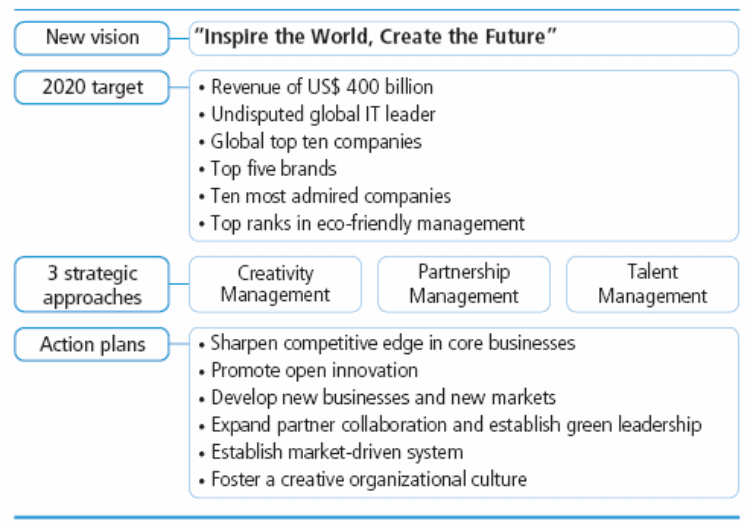
On the other hand, it is notable that at present the corporate arrangement of Samsung focuses more on information communications technology, telecommunication, AV, along with an orientation towards sets and gears; however, the vision for 2020 of the firm contains policies regarding integration of new business areas, like medical facilities, energy, and expediency with a highlight on software and solutions:
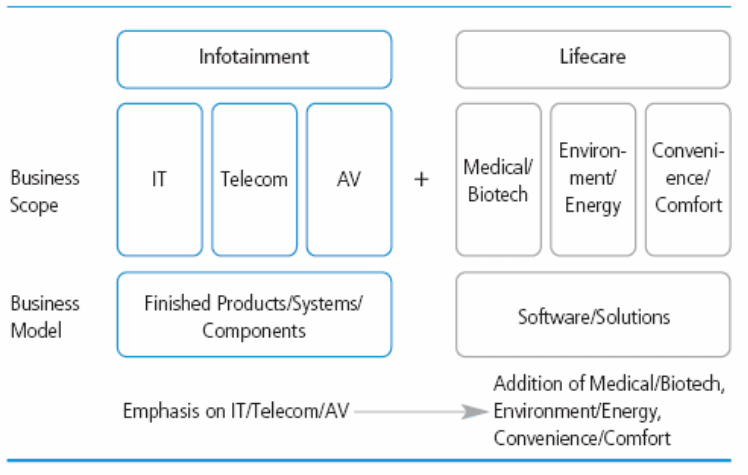
It is important to argue that although all these future strategies seem quite impressive, for long term development of the company in terms of growth and increasing market share, it is essential for it to come up with a number of fresh and innovative marketing strategies that can help achieving the objectives of the company successfully. Some such strategies will now come into focus; however, two of these marketing strategies should be consecutively short- term and middle- term, whilst the other would be long term.
Marketing Strategy 1 – : Multimedia Marketing Advertisements
By means of a proper integrated multimedia campaign, the company would be able to come up with stronger brand identity and more customer involvement. This variety of promotion may comprise in web marketing, including Search Engine Optimization (SEO), company’s own website development, blogs, e-mails, and more essentially, advertisement throughout social networking sites.
Social-networking websites are remarkable for constructing consumer relationships; furthermore, it is quite simple to connect with consumers at social websites; it comprises creating accounts at popular social-sites, assembling community/customers, providing accommodating information about product, and updating information frequently; conversely, consumers will enjoy joining the community as a place to share their experience and find information about what to acquire.
In addition, undeniably, the multimedia advertisements will be successful based on the fact that as individuals in any particular community “trust” each other, they would surely come up to go for buying electronics of Samsung if one says the electronic was an absolute pleasure to use; conversely, this strategy has strong appeal on the online consumers and regular internet users.
Moreover, another feature of online multimedia advertisement is that individuals connect in frequent, dynamic involvement and there are usually passionate communications, strapping emotional bonds and collective actions taking place amongst partakers; besides, there is trustworthiness of data, assistance, and amenities among individuals with the scope of mutual circumstance of communal gatherings, verbal communication, and procedures exist in these communities. Some other evaluation criteria of why choosing this strategy has outlined below:
- Image creation -This company is one of the leading brands in the global electronic product market; however, it has to face intense competition from some of the rivals with close substitutes, so, the decision-maker of the come should focus on multimedia advertising campaign to develop brand awareness further
- Aligns with mission – As this company would like to provide the best quality products to the customers, this multimedia advertising campaign would help the company to aware target customer regarding quality of the products
- Exploits core competency – It has already developed the product quality to avoid any controversy or dissatisfaction from the part of the customers; in addition, it uses its core competencies to operate in an ecologically friendly way; however, this information can pass on to the customers through the campaign
- Competition – To compete with the large competitors like some of the global giants like LG, the campaign will play vital role
- Creating loyal customer base – As some of the competitors offer similar products at lower prices, this campaign would help creating loyal customer base and would increase sales
- Financial risk – Considering the previous experience of some of the other companies it is arguable that the campaign has no financial risks for Samsung because the cost of carrying out the online multimedia advertisement is minimal
- Short and long term Growth rate – It would only boost short- term growth rate
- Think customer first – As the campaign would emphasis on the positive factors of Samsung, customer must be benefited from it
Marketing Strategy 2 – : Reformation of the Pricing Strategy:
The company should reform its pricing strategy to help all types of customers of being able to buy the product; therefore, the price of the products will have to be reasonable. The prices can be lowered down be reducing operational costs; some evaluation criteria of why the company should choose this strategy has outlined below:
- Aligns with vision – This strategy meets the vision to best serve the customers
- Exploits core competency – It should lower operational costs to implement this strategy; this can be done by more capacity utilisation
- Competition – This strategy will make the firm more competitive
- Differentiates and helps creating unique experience – This also creates price differentiation
- Creating loyal customer base – This will creating loyal customer base because of lower prices
- Short and long- term growth rate – This boosts long- term growth rate
- Degree of Flexibility – This makes the business a more flexible operator
Marketing Strategy 3 – : Diversification Strategy:
Some evaluation criteria of why the company should choose this strategy has outlined below:
- Builds brand awareness – Through a more diversified product line, the company’s brand awareness will increase
- Aligns with vision – This strategy is complied with the vision of the company
- Exploits core competency – It has addressed areas that can add value for electronics and this strategy would create new dimension to compete with competitors
- Differentiates and helps to create unique experience – Innovative product line would mean new experience for customers
- Short and long- term Growth rate – It would be possible to expand market for sustainable period
Works Cited
Kim, Renee. Samsung’s Competitive Innovation and Strategic Intent for Global Expansion. 2007. Web.
Samsung Electronics. Events Schedule. 2011. Web.
Samsung Electronics. History of Semiconductor Business. 2011. Web.
Samsung Electronics. Marketing Strategy of Samsung. 2009. Web.
Samsung Electronics. Samsung Electronics Announces Fourth Quarter & FY 2010 Results. 2010. Web.
Samsung Electronics. Sustainability Report 2009-2010 of Samsung. 2010. Web.
Samsung Electronics. Sustainability Report 2011 of Samsung. 2011. Web.
Scribd. SWOT analysis of Samsung Electronics. 2011. Web.
Yoo-chul, Kim. Sony, Apple, Dell are Samsung’s big buyers. 2010. Web.